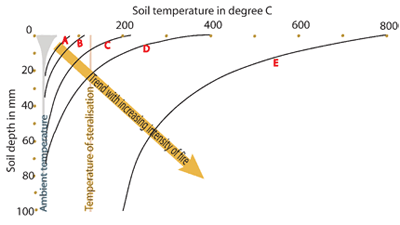Fire and its influence on soil
Types of fire and consequent heat waves
McKenzie et al (2004) developed the following illustration of heat waves from various types of fires. It is based on data from Walker et al (1986) and Humphreys and Craig (1981). It shows that it takes quite intense fires to penetrate far into the soil surface.
Penetration of fire generated head into a soil
 | Example ranging from A - a grassline fire, through to E - a windrow burn The particular detail of each heat wave (apart from fire intensity and duration) is modified by soil moisture content and soil type (texture and porosity). |
Changes to soil caused by fire
The following table (also from McKenzie et al., 2004), based on work of Walker et al., 1986 provides information on soil changes induced by fire induced soil temperatures
| Dominant type of change | Temperature (°C) | Effect |
| Biological | <25 | Usual soil temperatures |
| 37 | Maximum stimulation of soil microorganisms | |
| 50 | Mild sterilisation due to water loss | |
| 60 | Proteins denatured | |
| 70 | High nitrate mineralisation | |
| 100 | Soil ammonium production starts | |
| 110 | Soil water lost | |
| 125 | Soil sterilisation | |
| 200 | 1. Water repellence caused by distillation of volatiles 2. Loss of nitrogen commences | |
| Chemical | 300 | 1. Maximum amino acid nitrogen released 2. Loss of sulfur and phosphorus begins 3. Distillation and carbonisation of organic residues 4. Organic matter charred |
| 400 | Organic matter carbonised | |
| 420 | Water lost from within clay minerals causing change in type (e.g. illite converts to kaolinite) | |
| 540 | Little residual nitrogen or carbon left | |
| 600 | 1. Maximum loss of potassium and phosphorus 2. Fine ash produced. Organically bound cations form oxides | |
| Physical | 950 | Clay minerals converted to different phases |
| >1200 | Loss of calcium as gas |


